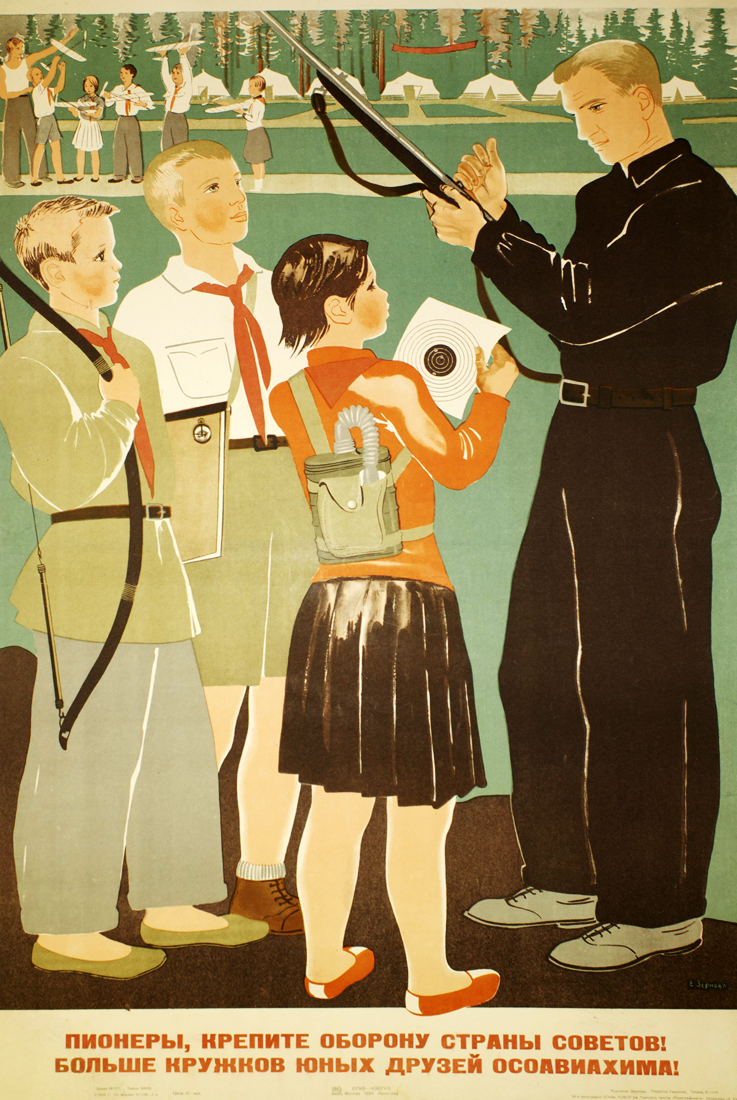
Pioneers, strengthen the defense of the country of Soviets! More circles of young friends of Osoaviakhim!
Poster Number: PP 720
Category: Youth
Poster Notes: Osoaviakhim was the "Union of Societies of Assistance to Defense and Aviation-Chemical Construction of the USSR". A military sub-organization with its own airfields, clubs, parachute towers and firing ranges. Created in 1927, its name was changed to DOSAAF (Volunteer Society for Cooperation with the Army, Aviation, and Navy) in 1951.
Media Size: 45.5x32
Poster Type: Lithograph
Publishing Date: 1934
Editorial Information: Editor Gavrilin; Technical Editor Leonov
Technical Information on Poster: January... 1934; Order No. 1227; Standard format 72 x 100; [Volume] 1 sheet of paper; Price 60 kopeks; [Printed at] 3 Mir Street
Print Run: 50,000
Catalog Notes: PP 720 Youth
Artist: Zernova, Ekaterina Sergeevna — Зернова, Екатерина Сергеевна
Ekaterina Sergeevna Zernova studied in Moscow at the private art school of the master painter Fedor Rerberg from 1915 to 1918. She continued her studies at GSKhM (State Free Artistic Studios) / VHKUTEMAS (Russian State Art and Technical School) where she graduated in 1924. She was a prominent artist with OST (Obshchestvo khudozhnikov-stankovistov), the Society of Easel Artists that was formed in 1924. When OST was terminated, she became a member of IzoBrigada (Art Brigade). Formed in 1931 to advance "...
Read More About This Artist
Printer: 24th Lithography Workshop of the Poligrafkniga Trust of Ogiz, Leningrad — 24-я типография ОГИЗа РСФСР треста Полиграфкнига, Ленинград
The 24th Lithography Workshop was located at Kronverkskaia and Mir Streets in Leningrad (St. Petersburg). Historically, the workshop had its roots in Imperial Russia and it was a large printing operation founded in 1881 by Theodore Kibbel (a.k.a. Fedor Fyodorovich Kibbel). Shortly after the printer was nationalized by the Soviets, it became the 1st State Lithography Workshop. In 1924, the workshop was named in honor of Mikhail Pavlovich Tomskii (1880-1936), head of the Soviet trade ...
Read More About This Printer
Publisher: Ogiz-IzoGiz, Moscow-Leningrad — Огиз-Изогиз, Москва-Ленинград
Ogiz was the Association of the State Book and Magazine Publishers. Its main offices were located in Moscow and in Leningrad. The Sovnarkom of the Russian Socialist Federative Soviet Republic established Ogiz in 1930 to centralize publishing activities under a state monopoly in order to eliminate duplication of printed material, streamline and control publishing production and output, and to create a base for marketing books, training and technical manuals. In 1931, the Central Committee of the USSR ...
Read More About This Publisher